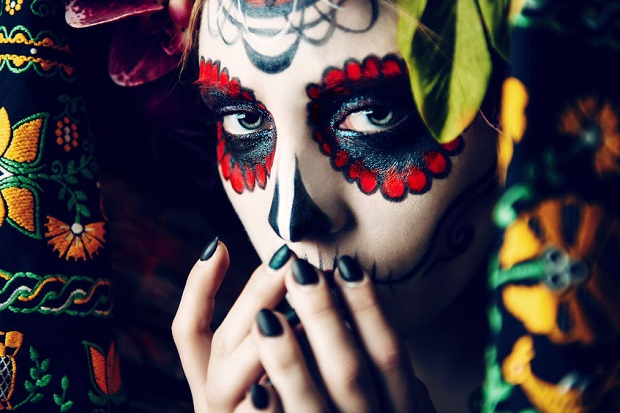
There are many birthmark meanings steeped in superstition and folklore. Before the advances in medical science, superstitions were used to explain every occurrence – from conception to death and disease to recovery. Today, people still repeat the “old wives’ tales” passed down from generation to generation. Here is a comprehensive collection of some of the more popular tales about how and why birthmarks appear.
Birthmark Meanings – Jump Ahead
- Birthmarks Are the Devil’s Mark or Sign of Something Evil
- Birthmarks Are Devine Messages from the Gods
- Birthmarks Are a Remnant of a Death Wound from a Previous Life
- Birthmark Location Meaning
- Birthmark Shape Meaning
- Maternal Impression Influences Birthmark Formation
- Birthmarks and Food Associations
- Birthmark Cultural Meanings
Birthmarks Are the Devil’s Mark or Sign of Something Evil

According to the book “Encyclopedia of Demons in World Religions and Cultures,” the idea that birthmarks are the devil’s mark on witches is a very dangerous belief that was the demise of many Puritan women in America in the late 1600s. The superstitious belief is that the devil places a supernatural brand or mark in an inconspicuous place on a witch’s body for identification purposes and to seal a demonic pact. Any woman having such a mark was labeled a witch and executed. [1]
In the book The Little Giant Encyclopedia of Superstitions, a collection of thousands of beliefs, omens, and proverbs, birthmarks are caused by an expectant mother seeing or being touched by something evil. [2]
Birthmarks Are Divine Messages from the Gods

In Ancient Greece, birthmarks were considered divine messages left or written by the gods on a person’s body. Especially if the mark were on the forehead. [3]
Birthmarks Remnants of a Death Wound in Previous Life

Some cultures that believe in reincarnation believe that a birthmark in this life is a deadly wound in another. For example, if a person dies of a gunshot wound, he would be reincarnated with a birthmark at the wound site. A long, slender birthmark may be a sword blow. [4]
Birthmark Location Meaning

Originally published in 1903, the contributors to the Encyclopædia of Superstitions, Folklore, and the Occult Sciences of the World: Volume I set out to collect information about cultural superstitions from across the globe.
They discovered what different cultures believed about what a birthmark signifies when present on a certain body part. In general, many believe that a birthmark located anywhere on the right side of the body is lucky, while the opposite is true for the left. [5]
Here are more cultural superstitions about the meaning of a birthmark’s location from the book:
- Face: If a woman has a birthmark on her face, she will live a life of misery and poverty. She will also be a false friend.
- Nose: A person lucky enough to have a birthmark on or near the nose will succeed in all his endeavors.
- Eyes: A person with a birthmark near an eye is quiet and trustworthy. He will also meet with a terrible death.
- The right side of the forehead: The person with the birthmark on the right side of the forehead will attain great power and honor. This is the likely outcome of a similar superstition that maintains that this position means the person has great mental power.
- The left side of the forehead: The person with a birthmark on the left side of the forehead will be thwarted in his deepest desire.
- Heart: Those with birthmarks over the heart will meet with a bloody death.
Birthmark Shape Meaning

The Little Giant Encyclopedia of Superstitions reports that the shape of a birthmark has meaning in some cultures. [6]
- Rounded birthmark: You will be fortunate if you have a rounded birthmark.
- Angular birthmark: Angular birthmarks are unlucky.
- Raised birthmark: If you are the bearer of a raised birthmark, you will be VERY lucky!
Maternal Impression Influences Birthmark Formation

The term maternal impression is the belief that a powerful influence on the mind of a pregnant woman will result in a mark on the unborn child. Many birthmark superstitions are steeped in this belief. Here are a few examples that the University of Detroit Mercy website readers shared about family folklore. [7]
- If a pregnant woman has a craving for something and does not get it, the baby will have a birthmark resembling the food that was craved.
- If a pregnant woman gets frightened and touches some part of her body, her child will be born with a birthmark on the same part of his or her body. The birthmark will be the same shape as the thing that frightened the mother.
- If a pregnant woman is frightened by fire, the baby will have a red or purple birthmark.
Birthmarks and Food Associations

According to Andrea Malossini, who has been studying, collecting, and writing for many years on topics regarding superstition and witchcraft and is the author of the book Italian Superstitions, maternal food cravings are greatly associated with birthmarks. The belief is that when a mother-to-be intensely craves a particular food, if she happens to touch herself during that moment, her baby will have a birthmark in the exact place. The following is an example of the type of birthmark associated with a particular food craving. [8]
- Dark birthmark with hair: craving for pork or rabbit
- Red birthmark shaped like a raspberry: desire for strawberries or cherries
- Purple birthmark: craving for red wine
- Dark brown spots: desire for coffee
- Spotted birthmarks: craving for grapes
- Long, pink birthmarks: craving for ham
- White spot: desire for milk
Birthmark Cultural Meanings

Many other beliefs surround birthmarks as well. Some cultures believe that birthmarks are lucky and should be touched. The Italian, Spanish, and Arabic words for birthmarks – voglie, antojos, and wiham, respectively – all mean “wishes.” [9]
In Iranian folklore, if a pregnant woman scratches herself while watching a lunar eclipse, her child will be born with a dark spot on its body and a hairy mole, called māh bagite (“lunar eclipse”). Also, those who look upon a pregnant woman and those she looks upon will influence her child’s features. [10]
The Greeks believe that a birthmark can be caused by an expectant mother who eats tomatoes on St. Simon’s Day. They also believe that black pepper causes moles and that moles are lucky. Throwing black pepper at an expectant mother on St. Simon’s Day is considered good practice. [11]
Resources
- [1] Bane, Theresa. Encyclopedia of Demons in World Religions and Cultures. United Kingdom, McFarland, Incorporated, Publishers, 2014.
- [2] The Little Giant Encyclopedia of Superstitions. United Kingdom, Sterling Publishing Company, 1999.
- [3] ‘Body Marks – Birthmarks. Body Divination in Ancient Literature and Iconography’, in A. Shapiro et al. (eds), Bodies in Transition. Dissolving the Boundaries of Embodied Knowledge (Morphomata), Munich, 2015, 155-177
- [4] Stephenson, Ian. Journal of Scientific Exploration; “Birthmarks and Birth Defects Corresponding to Wounds on Deceased Persons.” Vol. 7, No. 4, pp. 403-410, 1993
- [5] Encyclopædia of Superstitions, Folklore, and the Occult Sciences of the World: Volume I. United States, University Press of the Pacific, 2003.
- [6] The Little Giant Encyclopedia of Superstitions. United Kingdom, Sterling Publishing Company, 1999.
- [7] University of Detroit Mercy – “The James T. Callow Computerized Folklore Archive.”
- [8] Malossini, Andrea. Italian Superstitions. Italy, Andrea Malossini, 2013.
- [9] Berman, Michael. Georgia Through Its Legends, Folklore, and People. United States, Nova Science Publishers, 2011.
- [10] Encylopaedia Iranica – “Gilan xvi. Folklore.”
- [11] Encyclopaedia of Superstitions, Folklore, and the Occult Sciences of the World: A Comprehensive Library of Human Belief and Practice in the Mysteries of Life. United States, J. H. Yewdale & sons Company, 1903.





